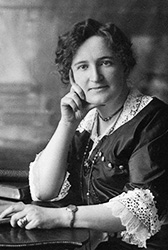Nellie McClung: Exercise 3 - Reading Comprehension
Answer the questions about the story.
Click on the box beside the correct answer.
The Story of Nellie McClung
 1 In 1882, a nine-year-old girl from the Prairies was at a community picnic. The summer sun was high in the sky. People sat on tablecloths spread over the green grass. They ate sandwiches and watermelon. They drank tea and lemonade. And the boys were lining up for a race. The nine-year-old girl wanted to run in that race. But she was told that races were for boys only. It was not nice for girls to run. Their skirts might fly up and their legs might show. A fire was lit inside her that day. One day, she would see to it that women could do the same things that men could do – like vote. Her name was Nellie McClung.
1 In 1882, a nine-year-old girl from the Prairies was at a community picnic. The summer sun was high in the sky. People sat on tablecloths spread over the green grass. They ate sandwiches and watermelon. They drank tea and lemonade. And the boys were lining up for a race. The nine-year-old girl wanted to run in that race. But she was told that races were for boys only. It was not nice for girls to run. Their skirts might fly up and their legs might show. A fire was lit inside her that day. One day, she would see to it that women could do the same things that men could do – like vote. Her name was Nellie McClung.2 Running in races wasn’t the only thing girls weren’t allowed to do. Back then, it was illegal for women to vote, be in government, own property, or go to university. This is because men were thought to be more reasonable than women. Only men were reasonable enough to take part in the world of government and business. Women were seen as emotional. This made them “more fit” for the world of homemaking and childcare.
3 When Nellie grew up, she poked holes in these old ideas. She spoke to large crowds in favour of women’s right to vote. Some Canadians worried that women’s rights would lead to the breakdown of the family. With a colourful hat on her head and a charming sense of humour, Nellie changed hearts and minds.
4 Women’s rights activists in Europe and America often used violence to get their point across. Nellie used humour, instead. She starred in a play where she debated men’s right to vote. She began by telling the men how nice they looked. Then she pointed out that most of the people in prison were men, and men made up only a small number of the people who went to church. How could these people be trusted with politics? Big crowds came to see Nellie’s play. They roared with laughter. It became fashionable to support women’s rights.
5 White women were finally allowed to vote in federal elections in 1918. As a result of racist laws, women of colour and Aboriginal women would not be allowed to vote until much later.
6 In 1921, Nellie served as one of the first female MLAs in the government of Alberta. It was often said that women’s involvement in politics would lead to divorce. Nellie and her husband Wes proved those claims wrong. Wes was proud of his wife. “I don’t mind being Mr. Nellie McClung,” he’d say with a smile.
7 One day, Nellie’s friend Emily Murphy invited some friends to her house for tea. They talked about how unfair it was that women were not allowed to sit in the Senate. This is because women were not seen as “persons” in the eyes of the law. The women decided to take the matter to court. After a long battle, they won the case in 1929 – but Nellie wasn’t finished. “The end is not yet!” she said. Even though women had won many legal rights, they were still not treated as equal to men. This was especially true of women of colour. Unlike most women’s rights activists of her time, Nellie called for an end to racism.
8 Even as she grew older and her health declined, she kept writing and speaking for equal rights. Nellie said, “Because I’ve got a bad heart, my doctor has told me not to write. I assume he meant books, so I keep busy on letters, editorials, and messages.” If she hadn’t died in 1951, she would probably still be fighting for women’s rights today.
Credits:
Story by Shantel Ivits at BC Open Textbooks
Adapted under Creative Commons license
Adaptations and exercises by Richard Carrington, English Language Centre
Photo (edited): Nellie McClung by Jkelly is in the public domain
Audio version performed by Peter Polgar, English Language Centre
Story by Shantel Ivits at BC Open Textbooks
Adapted under Creative Commons license
Adaptations and exercises by Richard Carrington, English Language Centre
Photo (edited): Nellie McClung by Jkelly is in the public domain
Audio version performed by Peter Polgar, English Language Centre

